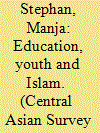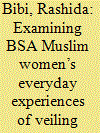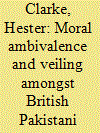| Srl | Item |
| 1 |
ID:
101298


|
|
|
|
|
| Publication |
2010.
|
| Summary/Abstract |
This article attempts to explain the growing popularity of private religious lessons in urban Tajikistan from a cross-generational perspective. By instilling discipline and good 'morals', religious lessons serve as a powerful tool to socialize adolescent and morally vulnerable urban youth into the established social order. The increasing demand for religious instruction on the part of Muslim parents not only reflects the growing importance of Islam in Tajikistan, but also highlights the weaknesses of state education and the constraints on family upbringing in neo-local urban households. By attending religious classes, male and female youth have found a space for negotiating religious identities and for realizing their own abilities and ambitions. Given the socio-economic hardships of everyday life in the post-Soviet city, a turn to Islam can promote integration, recognition and social mobility, and offer an alternative route for urban youth to become 'adults'.
|
|
|
|
|
|
|
|
|
|
|
|
|
|
|
|
| 2 |
ID:
187072


|
|
|
|
|
| Summary/Abstract |
In The Souls of Black Folk W.E.B Du Bois conceptualised arguably two of the most significant and powerful theories of race and racism, that of ‘the Veil’ and ‘double consciousness’. This paper utilises the concept of the veil both literally, in the case of non/veiling acts of British South Asian (BSA) Muslim women living in Oldham, but also metaphorically, through the Veil, as a form of social and cultural exclusion of Muslim women in everyday interactions. The paper argues that the use of the Veil and double consciousness, is able to highlight the extent to which Muslim women actively reflect upon hegemonic discourses of the veil as oppression and veil as respectability which shape understandings of them. The paper contends that an analytical use of ‘double consciousness’ in particular, can highlight the nuanced experiences of BSA Muslim women’s everyday lives.
|
|
|
|
|
|
|
|
|
|
|
|
|
|
|
|
| 3 |
ID:
160375


|
|
|
|
|
| Summary/Abstract |
This article explores perceptions and performances of veiling as they are mediated by notions of piety, overlapping and alternative moral narratives, and understandings of belonging. For the young British Pakistani women I met in Sheffield, expressions of piety such as veiling, are negotiated through an underlying understanding of possessing ‘good intention’ and related moral discourses of being a ‘good person’ and a ‘good girl’. Discussions of what it means to be ‘good’, whether explored through narratives of piety, universal personhood or gendered ethnic identity, are mediated by relations with kin, the wider Pakistani community and understanding of British multiculturalism. In this article, the author argues that veiling practices should be explored not only through the multiple moral discourses which influence women's choices, but the wider raced and classed structures in which such choices are embedded.
|
|
|
|
|
|
|
|
|
|
|
|
|
|
|
|